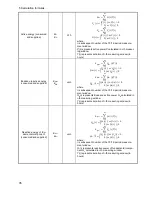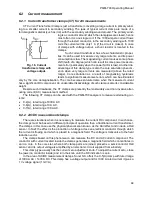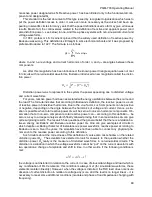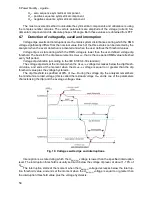
6 Power Quality - a guide
49
And then, is really
D
B
a measure of such distortion? Unfortunately, also in this case the Bude-
anu’s power theory fails. It has been proven that the
distortion power
can be equal to zero in a
situation when voltage is distorted in relation to current waveform, and vice versa, the
distortion
power
can be non-zero at total absence of distortion.
Practical aspect of this power theory which relates to improvement of power factor in systems
with reactive power was to be the feature to take the most advantage of correct definitions of reac-
tive power. The compensation attempts based on the Budeanu reactive power and related distortion
power fell through. These magnitudes did not allow even a correct calculation of correction capaci-
tance which gives the maximum power factor. Sometimes, such attempts ended even with addi-
tional deterioration of power factor.
How come, then, that the Budeanu’s power theory has become so popular? There may be
several reasons. Firstly, engineers got accustomed to old definitions and the curricula in schools
have not been changed for years. This factor is often underestimated, though as a form of justifica-
tion it can be said that this theory had not been refuted for 60 years. Secondly, in the 1920s there
were no measuring instruments which could give insight in individual voltage and current harmonic
components and it was difficult to verify new theories. Thirdly, distorted voltage and current wave-
forms (i.e. with high harmonics contents) are a result of revolution in electrical power engineering
which did not start before the second part of the last century. Thyristors, controlled rectifiers, con-
verters, etc. began to be widely used. All these caused very large current distortion in the mains,
and consequently increased harmonic distortion. Only then, were the deficiencies of the Budeanu’s
theory felt. Finally, fourthly, the scientific circles related to power utilities were aware of the fact that
industrial plants had invested a fortune in the measuring infrastructure (energy meters). Each
change is this respect could bring about huge financial consequences.
However, slow changes became visible in the views of electrical engineers. With time, as non-
linear loads were more and more frequent and the waveforms more and more distorted, the limita-
tions of used formulas could no longer be tolerated.
A very significant event was the 200
0 publication by IEEE of the standard 1459 called “Defini-
tions for the Measurement of Electric Power Quantities Under Sinusoidal, Non-Sinusoidal, Bal-
anced, or Unbalanced Conditions”. For the first time, Budeanu’s definition of reactive power has
been listed as not recommended which should not be used in new reactive power and energy me-
ters. Many magnitudes have been also divided into the part related to the current and voltage fun-
damental component (first harmonics) and the part related to remaining higher harmonics. In most
cases, it is recognized that the usable part of energy is transmitted by the 50/60Hz components,
with much smaller (and often harmful) participation of higher harmonics.
The standard also introduced a new magnitude
–
nonactive power N
which represents all non-
active components of power:
𝑁 = √𝑆
2
− 𝑃
2
Reactive power is one of the components of nonactive power N. In one-phase systems with
sinusoidal voltage and current waveforms, N equals Q; hence the nonactive power does not have
any other components. In three-phase systems, this is true only for symmetrical sinusoidal systems
with a balanced purely resistive load.
Other nonactive power components are related to concrete physical phenomena. According to
the professor Czarnecki’s theory, which is one of the best in explaining the physical phenomena in
three-phase systems, the power equation in such systems is as follows:
𝑆
2
= 𝑃
2
+ 𝐷
𝑠
2
+ 𝑄
2
+ 𝐷
𝑢
2
D
s
is the scattered power which appears in the system as a result of changing load conductance
with frequency. Hence, presence of reactive elements in the system may cause the scattered power.
In this equation, reactive power
Q
appears when there is a phase shift between the voltage and
current harmonics.
D
u
means the unbalanced power which is a measure of unbalance of a three-phase receiver.
Summary of Contents for PQM-700
Page 85: ...85 Notes...
















































